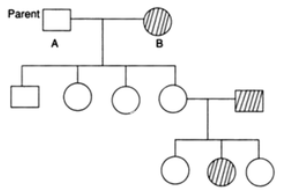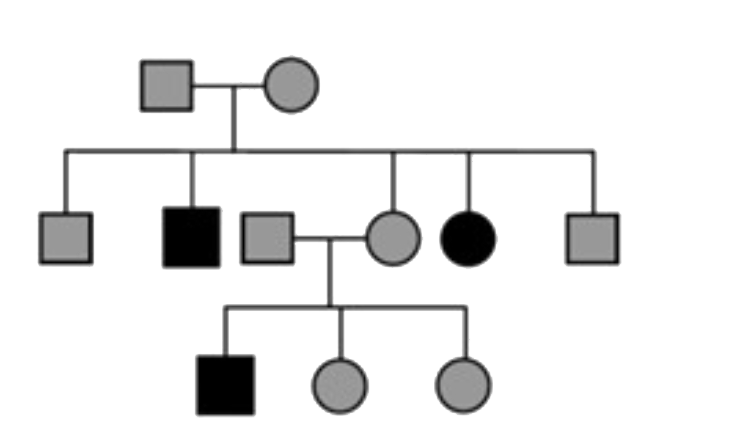If both parents are carriers for thalassaemia, which is an autosomal recessive disorder what are the chances of pregnancy resulting in an affected child ?
25%
100%
No chance
50%
The correct Answer is:A
To determine the chances of a pregnancy resulting in an affected child when both parents are carriers for thalassemia, we can follow these steps:
1. Understand the Genetic Basis: Thalassemia is an autosomal recessive disorder. This means that an individual must inherit two copies of the mutated gene (one from each parent) to be affected by the disorder.
2. Identify Genotypes of Parents: Since both parents are carriers, their genotypes can be represented as:
- Parent 1: Aa (carrier)
- Parent 2: Aa (carrier)
Here, 'A' represents the normal allele and 'a' represents the thalassemia allele.
3. Set Up a Punnett Square: To find the possible genotypes of the offspring, we can set up a Punnett square:
Aa−−−−−−−−−−−−−−−−−A|∀|Aa|−−−−−−−−−−−−−−−−−a|Aa|aa|−−−−−−−−−−−−−−−−−
- The rows and columns represent the alleles contributed by each parent.
4. Determine Offspring Genotypes: From the Punnett square, we can see the possible combinations of alleles for the offspring:
- AA (normal)
- Aa (carrier)
- Aa (carrier)
- aa (affected)
5. Count the Outcomes:
- 1 AA (normal)
- 2 Aa (carriers)
- 1 aa (affected)
6. Calculate the Probability: To find the probability of having an affected child (aa), we take the number of affected offspring over the total number of offspring:
- Probability of affected child = Number of affected (aa) / Total outcomes = 1 / 4 = 25%
7. Conclusion: Therefore, the chances of a pregnancy resulting in an affected child when both parents are carriers for thalassemia is 25%.
Final Answer:
The chances of pregnancy resulting in an affected child is 25%.
---
- Parent 1: Aa (carrier)
- Parent 2: Aa (carrier)
Here, 'A' represents the normal allele and 'a' represents the thalassemia allele.
Aa−−−−−−−−−−−−−−−−−A|∀|Aa|−−−−−−−−−−−−−−−−−a|Aa|aa|−−−−−−−−−−−−−−−−−
- The rows and columns represent the alleles contributed by each parent.
- AA (normal)
- Aa (carrier)
- Aa (carrier)
- aa (affected)
- 1 AA (normal)
- 2 Aa (carriers)
- 1 aa (affected)
- Probability of affected child = Number of affected (aa) / Total outcomes = 1 / 4 = 25%
The chances of pregnancy resulting in an affected child is 25%.
Topper's Solved these Questions
- PRINCIPLES OF INHERITANCE & VARIATIONBOOK - NCERT FINGERTPS ENGLISHCHAPTER - PRINCIPLES OF INHERITANCE & VARIATIONEXERCISE - HOTS
5 Videos
- PRINCIPLES OF INHERITANCE & VARIATIONBOOK - NCERT FINGERTPS ENGLISHCHAPTER - PRINCIPLES OF INHERITANCE & VARIATIONEXERCISE - EXEMPLAR
17 Videos
- PRACTICE PAPERSBOOK - NCERT FINGERTPS ENGLISHCHAPTER - PRACTICE PAPERSEXERCISE - Practice paper
150 Videos
- REPRODUCTION IN ORGANISMBOOK - NCERT FINGERTPS ENGLISHCHAPTER - REPRODUCTION IN ORGANISMEXERCISE - All Questions
137 Videos
Similar Questions
If both parents are carriers for thalessemia, which is an autosomal recessive disorder, what are the chances for pregnancy resulting in an affected child?
View SolutionIf both the parents are carriers for thalassemia which is an autosomal recessive disorder what are the chances of pregnancy resulting in an affected child
View SolutionIf both parents are carriers for thalassemia, which is an autosomal recessive disorder, what are the chances of pregnant women resulting in an affected child?
View SolutionIf both parents are carriers for thalessemia, which is ai:, autosomal recessive disorder, what are the chan~e~ pregnancy resulting in an affected child?
View SolutionIf both the parents are carriers of autosomal r recessive disorder thalassemia , what are the chances of pregnancy resulting in an affected child
View SolutionWhich one of the following is an example of an autosomal recessive disorder?
View SolutionIf a mother and father both have one mutant gene for a disease with an autosomal dominant inheritance, what is their risk of having an affected child?
View SolutionGiven pedigree shows inheritance of autosomal recessive gene. What is the genotype of given parents ?

View SolutionIf both parent are bald and their first female child is normal, then the chances of baldness in their second male child is :-
View SolutionGiven pedigree belongs to autosomal recessive disorder , which of the following represents parental genotypes correctly ?

View Solution
